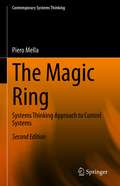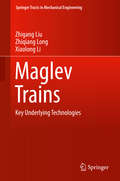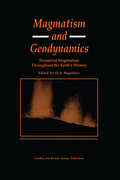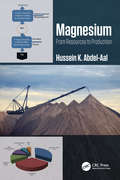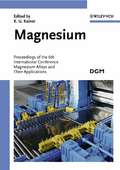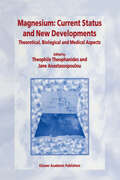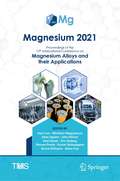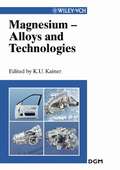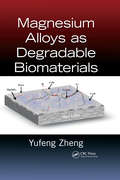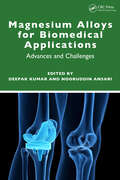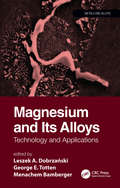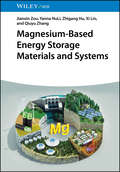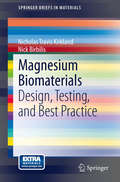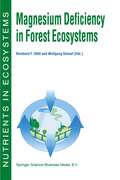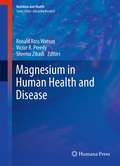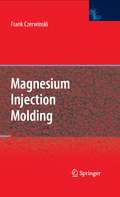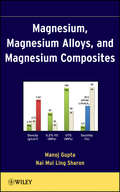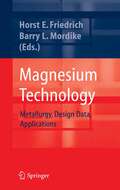- Table View
- List View
The Magic Ring: Systems Thinking Approach to Control Systems (Contemporary Systems Thinking)
by Piero MellaThis book presents a new understanding on how control systems truly operate, and explains how to recognize, simulate, and improve control systems in all fields of activity. It also reveals the pervasive, ubiquitous and indispensable role of control processes in our life and the need to develop a “control-oriented thinking”—based on uncomplicated but effective models derived from systems thinking—that is, a true “discipline of control.” Over the book’s thirteen chapters, Piero Mella shows that there are simple control systems (rather than complex ones) that can easily help us to manage complexity without drawing upon more sophisticated control systems. It begins by reviewing the basic language of systems thinking and the models it allows users to create. It then introduces the control process, presenting the theoretical structure of three simple control systems we all can observe in order to gain fundamental knowledge from them about the basic structure of a control system. Then, it presents the anatomy of the simplest “magic ring” and the general theoretical model of any control system. This is followed by an introduction to a general typology of control systems and a broader view of control systems by investigating multi-lever control systems and multi-objective systems. The book undertakes the concepts through various environments, increasingly broader in scope to suggest to readers how to recognize therein control systems manifestations in everyday life and in natural phenomena. Updated for the 2nd edition, new chapters explore control systems regulating the biological environment and the organizations, with an in-depth study of the control of quality, productivity, production, stocks and costs. Finally, it concludes by dealing with the learning process, problem-solving, and designing the logical structure of control systems.
Maglev Trains: Key Underlying Technologies (Springer Tracts in Mechanical Engineering)
by Zhigang Liu Zhiqiang Long Xiaolong LiThe motion of the train depends on the traction of linear motors in the vehicle. This book describes a number of essential technologies that can ensure the safe operation of Maglev trains, such as suspension and orientation technologies, network control and diagnosis technologies.This book is intended for researchers, scientists, engineers and graduate students involved in the rail transit industry, train control and diagnosis, and Maglev technology.
Magmatism and Geodynamics: Terrestrail Magmatism Throughout the Earth's History
by O. A. BagatikovMagnatism is the only true endogenic process for generating new material on the Earth's surface. Obviously, magmatism and tectonic movements are reflections of geodynamics, that is, physical processes which occur in deep-seated environments. What are the interrelationships between magmatism and tectronics? How did the character of terrestrial magmatism change through time and are there any irregularities in this process?
Magmatism and Geodynamics: Terrestrail Magmatism Throughout the Earth's History
by O. A. BogatikovMagnatism is the only true endogenic process for generating new material on the Earth's surface. Obviously, magmatism and tectonic movements are reflections of geodynamics, that is, physical processes which occur in deep-seated environments. What are the interrelationships between magmatism and tectronics? How did the character of terrestrial magmatism change through time and are there any irregularities in this process?
Magnesium: From Resources To Production
by Hussein K. Abdel-AalMagnesium is one of the most abundant minerals in seawater. Extracting magnesium from seawater could reduce cost of this mineral, resulting in positive implications for industries that use it. This book addresses mineral process engineering with emphasis on magnesium and provides practicing engineers and students with comprehensive knowledge on magnesium and how it is extracted from seawater and magnesium ores. It takes a chemical engineering approach as separation of magnesium from seawater involves the application of the powerful science of chemistry and transport phenomena principles. This monograph discusses magnesium resources and occurrence, includes an exploration study on deriving magnesium and mineral salts from seawater, and features coverage of magnesium chloride. It also covers commercial methods for magnesium production as an end product, current and prospective applications in the energy domain, and offers an account of the use of magnesium to store hydrogen in the form of magnesium hydride.
Magnesium: Proceedings of the 6th International Conference - Magnesium Alloys and Their Applications
by Karl U. KainerThe need for light-weight materials, especially in the automobile industry, created renewed interest in innovative applications of magnesium materials. This demand has resulted in increased research and development activity in companies and research institutes in order to achieve an improved property profile and better choice of alloy systems. Here, development trends and application potential in different fields like the automotive industry and communication technology are discussed in an interdisciplinary framework.
Magnesium: Theoretical, Biological and Medical Aspects
by T. Theophanides Jane AnastassopoulouThis book presents the lectures and posters of some of the main leaders in the field of th magnesium research and medical applications delivered at the 8 International Symposium on Magnesium, which took place on 5-9 October, 1997 in Heraklion, Crete under the chairmanship of Professor Theophilos Theophanides. The meeting was sponsored by the National Technical University of Athens and Ministry of Industry, Energy and Technology. The aim of this meeting was to promote research and applications of magnesium and interface between medical doctors, clinicians and scientists in order to understand the mechanisms responsible for magnesium involvement in the pathogenesis of diseases, its biological significance, metabolism and many other utilizations which are associated with membranes and cells. The success of this interface is due to the contribution of its participants who came from all continents and to their high scientific level. The topics, which were presented, and the questions, which were asked, concerned mechanisms of mode of action of free magnesium cations, Mg2+, hydrated cations, 2 Mg2+. 6 HP, and magnesium linked cations Mg +.LxH 0, where L: ligand and x = 2 1...6 Hp. We would like to express our utmost gratitude to the sponsers and to extend our deep appreciation and thanks to all those who helped and encouraged the scientific and material organization of this meeting. We wish to thank all the members of the scientific committee and the organizing committee.
Magnesium 2021: Proceedings of the 12th International Conference on Magnesium Alloys and Their Applications (The Minerals, Metals & Materials Series)
by Bruce Williams John Allison Warren Poole Alan Luo Eric Nyberg Sean Agnew Mihriban Pekguleryuz Karl Kainer Kumar Sadayappan Steve YueThis collection from the 12th International Conference on Magnesium Alloys and Their Applications (Mg 2021)—the longest running conference dedicated to the development of magnesium alloys—covers the breadth of magnesium research and development, from primary production to applications to end-of-life management. Authors from academia, government, and industry discuss new developments in magnesium alloys and share valuable insights. Topics in this volume include but are not limited to the following: Primary production Alloy development Solidification and casting processes Forming and thermo-mechanical processing Other manufacturing process development (including joining and additive manufacturing) Corrosion and protection Modeling and simulation Structural, functional, biomedical, and energy applicationsAdvanced characterization and fundamental theoriesRecycling and environmental issues
Magnesium Alloys and Technologies
by Karl U. KainerThe need for light-weight materials, especially in the automobile industry, created renewed interest in innovative applications of magnesium materials. This demand has resulted in increased research and development activity in companies and research institutes in order to achieve an improved property profile and better choice of alloy systems. Here, development trends and application potential in different fields like the automotive industry and communication technology are discussed in an interdisciplinary framework.
Magnesium Alloys as Degradable Biomaterials
by Yufeng ZhengMagnesium Alloys as Degradable Biomaterials provides a comprehensive review of the biomedical applications of biodegradable magnesium and its alloys. Magnesium has seen increasing use in orthopedic and cardiovascular applications over the last decade, particularly for coronary stents and bone implants.The book discusses the basic concepts of biodeg
Magnesium Alloys as Degradable Biomaterials
by Yufeng ZhengMagnesium Alloys as Degradable Biomaterials provides a comprehensive review of the biomedical applications of biodegradable magnesium and its alloys. Magnesium has seen increasing use in orthopedic and cardiovascular applications over the last decade, particularly for coronary stents and bone implants.The book discusses the basic concepts of biodeg
Magnesium Alloys for Biomedical Applications: Advances and Challenges
by Deepak Kumar Nooruddin AnsariMagnesium alloys have enormous potential for use in biomedical implants. Magnesium Alloys for Biomedical Applications delves into recent advances and prospects for implementation and provides scientific insights into current issues posed by Mg alloy materials. It provides an overview of research on their mechanical and tribological characteristics, corrosion tendencies, and biological characteristics, with a particular emphasis on biomedical implants. Details the fundamentals of Mg alloys as well as necessary surface modifications of Mg alloys for biomedical use. Discusses emerging Mg alloys and their composites. Covers mechanical, tribological, and chemical properties, as well as fatigue and corrosion. Highlights emerging manufacturing methods and advancements in new alloy design, composite manufacturing, unique structure design, surface modification, and recyclability. Helps readers identify appropriate Mg-based materials for their applications and select optimal improvement methods. Summarizes current challenges and suggests a roadmap for future research. Aimed at researchers in materials and biomedical engineering, this book explores the many breakthroughs achieved with these materials and where the field should concentrate to ensure the development of safe and reliable Mg alloy-based implants.
Magnesium Alloys for Biomedical Applications: Advances and Challenges
by Deepak Kumar Nooruddin AnsariMagnesium alloys have enormous potential for use in biomedical implants. Magnesium Alloys for Biomedical Applications delves into recent advances and prospects for implementation and provides scientific insights into current issues posed by Mg alloy materials. It provides an overview of research on their mechanical and tribological characteristics, corrosion tendencies, and biological characteristics, with a particular emphasis on biomedical implants. Details the fundamentals of Mg alloys as well as necessary surface modifications of Mg alloys for biomedical use. Discusses emerging Mg alloys and their composites. Covers mechanical, tribological, and chemical properties, as well as fatigue and corrosion. Highlights emerging manufacturing methods and advancements in new alloy design, composite manufacturing, unique structure design, surface modification, and recyclability. Helps readers identify appropriate Mg-based materials for their applications and select optimal improvement methods. Summarizes current challenges and suggests a roadmap for future research. Aimed at researchers in materials and biomedical engineering, this book explores the many breakthroughs achieved with these materials and where the field should concentrate to ensure the development of safe and reliable Mg alloy-based implants.
Magnesium and Its Alloys: Technology and Applications (Metals And Alloys Ser.)
by Leszek A. Dobrzanski Menachem Bamberger George E. TottenMagnesium and Its Alloys: Technology and Applications covers a wide scope of topics related to magnesium science and engineering, from manufacturing and production to finishing and applications. This handbook contains thirteen chapters, each contributed by experts in their respective fields, and presents a broad spectrum of new information on pure magnesium, magnesium alloys, and magnesium matrix MgMCs composites. It covers such topics as computational thermodynamics, modern Mg-alloys with enhanced creep or fatigue properties, cutting-edge approaches to melt treating (grain refinement, micro-alloying, and the resulting solidification and growth), coatings, surface engineering, environmental protection (recycling and green energy storage and production), as well as biomedical applications. Aimed at researchers, professionals, and graduate students, the book conveys comprehensive and cutting-edge knowledge on magnesium alloys. It is especially useful to those in the fields of materials engineering, mechanical engineering, manufacturing engineering, and metallurgy.
Magnesium and Its Alloys: Technology and Applications (Metals And Alloys Ser.)
by Leszek A. Dobrzański, George E. Totten and Menachem BambergerMagnesium and Its Alloys: Technology and Applications covers a wide scope of topics related to magnesium science and engineering, from manufacturing and production to finishing and applications. This handbook contains thirteen chapters, each contributed by experts in their respective fields, and presents a broad spectrum of new information on pure magnesium, magnesium alloys, and magnesium matrix MgMCs composites. It covers such topics as computational thermodynamics, modern Mg-alloys with enhanced creep or fatigue properties, cutting-edge approaches to melt treating (grain refinement, micro-alloying, and the resulting solidification and growth), coatings, surface engineering, environmental protection (recycling and green energy storage and production), as well as biomedical applications. Aimed at researchers, professionals, and graduate students, the book conveys comprehensive and cutting-edge knowledge on magnesium alloys. It is especially useful to those in the fields of materials engineering, mechanical engineering, manufacturing engineering, and metallurgy.
Magnesium-Based Energy Storage Materials and Systems
by Jianxin Zou Yanna NuLi Zhigang Hu Xi Lin Qiuyu ZhangMagnesium-Based Energy Storage Materials and Systems Understand the energy storage technologies of the future with this groundbreaking guide Magnesium-based materials have revolutionary potential within the field of clean and renewable energy. Their suitability to act as battery and hydrogen storage materials has placed them at the forefront of the world’s most significant research and technological initiatives. It has never been more essential that professionals working in energy storage and energy systems understand these materials and their extraordinary potential applications. Magnesium-Based Energy Storage Materials and Systems provides a thorough introduction to advanced Magnesium (Mg)-based materials, including both Mg-based hydrogen storage and Mg-based batteries. Offering both foundational knowledge and practical applications, including step-by-step device design processes, it also highlights interactions between Mg-based and other materials. The result is an indispensable guide to a groundbreaking set of renewable energy resources. Magnesium-Based Energy Storage Materials and Systems readers will also find: In-depth analysis of the effects of employing catalysts, nano-structuring Magnesium-based materials, and many more subjectsDetailed discussion of electrolyte, cathode, and anode materials for Magnesium batteriesSnapshots of in-progress areas of research and development Magnesium-Based Energy Storage Materials and Systems is ideal for materials scientists, inorganic chemists, solid state chemists, electrochemists, and chemical engineers.
Magnesium-Based Energy Storage Materials and Systems
by Jianxin Zou Yanna NuLi Zhigang Hu Xi Lin Qiuyu ZhangUnderstand the energy storage technologies of the future with this groundbreaking guide Magnesium-based materials have revolutionary potential within the field of clean and renewable energy. Their suitability to act as battery and hydrogen storage materials has placed them at the forefront of the world#s most significant research and technological initiatives. It has never been more essential that professionals working in energy storage and energy systems understand these materials and their extraordinary potential applications. Magnesium-Based Energy Storage Materials and Systems provides a thorough introduction to advanced Magnesium (Mg)-based materials, including both Mg-based hydrogen storage and Mg-based batteries. Offering both foundational knowledge and practical applications, including step-by-step device design processes, it also highlights interactions between Mg-based and other materials. The result is an indispensable guide to a groundbreaking set of renewable energy resources. Magnesium-Based Energy Storage Materials and Systems readers will also find: In-depth analysis of the effects of employing catalysts, nano-structuring Magnesium-based materials, and many more subjects Detailed discussion of electrolyte, cathode, and anode materials for Magnesium batteries Snapshots of in-progress areas of research and development Magnesium-Based Energy Storage Materials and Systems is ideal for materials scientists, inorganic chemists, solid state chemists, electrochemists, and chemical engineers.
Magnesium Biomaterials: Design, Testing, and Best Practice (SpringerBriefs in Materials)
by Nicholas Travis Kirkland Nick BirbilisMagnesium Biomaterials provides a succinct up-to-date overview of Magnesium biomaterial development, critically examines the types of in vitro experiments that may be performed, and investigates the numerous variables that affect Magnesium biodegradation when undertaking these experiments. This work also discusses the direction in which current Magnesium biomaterial development is heading and the necessary steps for future development of this field. Information is drawn from numerous multi-disciplinary sources to provide a coherent and critical overview. Magnesium Biomaterials is ideal for researchers in the area of bio-Mg, companies interested in exploring their own alloys, and for researchers working with other biodegradable materials who are seeking a cross-platform understanding of material performance.
Magnesium Deficiency in Forest Ecosystems (Nutrients in Ecosystems #1)
by Reinhard F. Hüttl Wolfgang W. SchaafR. F. HUTTL AND W. SCHAAF Brandenburg Technical University Cottbus, Chair of Soil Protection and Recultivation, P.O. Box 10 13 44, 03013 Cottbus, Germany The health status of forest trees and stands is determined by numerous site factors such as chemical, physical, and biological soil factors, water supply, climate, weather conditions, management history as well as atmospheric deposition impacts. In this context, the nutrient supply is an important evaluation parameter. Forest trees well supplied with nutrients are more resistant to stresses that affect the forest ecosystem than other trees. This is true for both biotic and abiotic influences. Therefore the investigation of the so-called 'new type forest damage' was aimed at the exact determination of the health status of damaged trees. When considering the complete forest ecosystem, health (=vitality) means the sustainable ability to withstand negative environmental influences and still remain stable and productive. From this viewpoint, an optimal nutritional status is a prerequisite for an optimal health status. The term 'new type forest damage' comprises a number of damage symptoms which have been observed in various tree species on very different sites since the mid-1970s, particularly in Europe and North America. However, they occurred much more intensively in the 1980s. Generally, this forest damage was thought to be related to negative impacts of air pollutants.
Magnesium: From Resources to Production
by Hussein K. Abdel-AalMagnesium is one of the most abundant minerals in seawater. Extracting magnesium from seawater could reduce cost of this mineral, resulting in positive implications for industries that use it. This book addresses mineral process engineering with emphasis on magnesium and provides practicing engineers and students with comprehensive knowledge on magnesium and how it is extracted from seawater and magnesium ores. It takes a chemical engineering approach as separation of magnesium from seawater involves the application of the powerful science of chemistry and transport phenomena principles. This monograph discusses magnesium resources and occurrence, includes an exploration study on deriving magnesium and mineral salts from seawater, and features coverage of magnesium chloride. It also covers commercial methods for magnesium production as an end product, current and prospective applications in the energy domain, and offers an account of the use of magnesium to store hydrogen in the form of magnesium hydride.
Magnesium in Human Health and Disease (Nutrition and Health)
by Ronald Ross Watson, Victor R. Preedy and Sherma ZibadiMagnesium is an essential mineral which is required for growth and survival of humans. Since magnesium is a mineral and not synthesizable it must be obtained through dietary foods and/or supplements. Magnesium in Human Health and Disease reviews the benefits of magnesium supplementation to reach recommended intakes as well as provides new research that suggests how reaching levels above the recommended intakes can promote health and treat various diseases. Magnesium deficiency can cause low serum potassium and calcium levels, retention of sodium, and low circulating levels of regulatory hormones. These changes in nutrients cause neurological and muscular symptoms such as tremor and muscle spasms. Further magnesium deficiency causes loss of appetite, nausea, vomiting, personality changes and death from heart failure. Causes of magnesium deficiency include alcohol abuse, poorly controlled diabetes, excessive or chronic vomiting and/or diarrhea. Thus the effects of inadequate and deficient intakes or levels of magnesium is critical to health and are reviewed by the expert clinicians in this book. Magnesium in Human Health and Disease provides the most current research to support the potential benefits or lack thereof for normal and high supplementation with magnesium. Animal model research and early human trials are reviewed to document other disease states such as hypertension, cholesterol level, type 2 diabetes and cardiovascular disease that would benefit from increased magnesium.
Magnesium Injection Molding
by Frank CzerwinskiThe objective of this book, being the first one on magnesium injection molding, is to treat both the scientific background and the technological aspects as they are understood at present. All aspects of material development, manufacturing and engineering are covered. The book provides a single source of information covering the interdisciplinary field of net shape forming of magnesium alloys. It reflects a unique blend of science and industrial practice.
Magnesium, Magnesium Alloys, and Magnesium Composites
by Manoj Gupta Sharon Nai Mui LingA look at the current and future uses of magnesium-based products and their role in the world's environmental and technological revolution The lightest of all structural metals, having one-fourth the density of steel and two-thirds that of aluminum, magnesium has already been adopted as an alternative construction material in applications as far ranging as automotive and sports equipment, electronics, and space technology. In a world concerned with minimizing the environmental impact of products, the choice of light-weight, energy-saving, and high-performance materials, like magnesium, would seem a small, significant step towards improving life on this planet. Magnesium, Magnesium Alloys, and Magnesium Composites introduces the science and current applications of this important metal, shedding light on the magnesium-based composites developed over the last fifteen years. Chapters include in-depth discussion of: The characteristics of pure magnesium—including atomic properties and crystal structure as well as physical, electrical, and mechanical properties Magnesium alloys—and the effects of the alloying elements, such as aluminum, lithium, copper, nickel, and silicon The properties of magnesium-based composites—and the effects of different types (metallic, ceramic, interconnected, and intermetallic) of reinforcements of varying length (from micron scale to nanometric length) Corrosion aspects of magnesium-based materials Magnesium-based products in medicine, sports equipment, and the automotive, aerospace, and electronics industries Bringing together, for the first time, the science, properties, and technologies relating to the current and future uses of magnesium, this important reference also offers readers a glimpse of a not-too-distant world in which environmental safety and sound engineering are a reality.
Magnesium, Magnesium Alloys, and Magnesium Composites: Processing, Mechanical And Corrosion Characteristics (Springerbriefs In Materials Ser.)
by Manoj Gupta Sharon Nai Mui LingA look at the current and future uses of magnesium-based products and their role in the world's environmental and technological revolution The lightest of all structural metals, having one-fourth the density of steel and two-thirds that of aluminum, magnesium has already been adopted as an alternative construction material in applications as far ranging as automotive and sports equipment, electronics, and space technology. In a world concerned with minimizing the environmental impact of products, the choice of light-weight, energy-saving, and high-performance materials, like magnesium, would seem a small, significant step towards improving life on this planet. Magnesium, Magnesium Alloys, and Magnesium Composites introduces the science and current applications of this important metal, shedding light on the magnesium-based composites developed over the last fifteen years. Chapters include in-depth discussion of: The characteristics of pure magnesium—including atomic properties and crystal structure as well as physical, electrical, and mechanical properties Magnesium alloys—and the effects of the alloying elements, such as aluminum, lithium, copper, nickel, and silicon The properties of magnesium-based composites—and the effects of different types (metallic, ceramic, interconnected, and intermetallic) of reinforcements of varying length (from micron scale to nanometric length) Corrosion aspects of magnesium-based materials Magnesium-based products in medicine, sports equipment, and the automotive, aerospace, and electronics industries Bringing together, for the first time, the science, properties, and technologies relating to the current and future uses of magnesium, this important reference also offers readers a glimpse of a not-too-distant world in which environmental safety and sound engineering are a reality.
Magnesium Technology: Metallurgy, Design Data, Applications
by Horst E. Friedrich Barry Leslie MordikeMagnesium, with a density of 1.74 g/cm², is the lightest structural metal and magnesium are increasingly chosen for weight-critical applications such as in land-based transport systems. "Magnesium Technology" substantially updates and complements existing reference sources on this key material. It assembles international contributions from seven countries covering a wide range of research programs into new alloys with the requisite property profiles, i.e., the current state of both research and technological applications of magnesium. In particular, the international team of authors covers key topics, such as: casting and wrought alloys; fabrication methods; corrosion and protection; engineering requirements and strategies, with examples from the automobile, aerospace, and consumer-goods industries, and recycling. This authoritative reference and overview addresses materials researchers as well as design engineers.
